1 IBU “Season’s thoughts” 1949, réinterprétée par Athéna Poilâne 2011, IBU GALLERY EDITION ®
2 Choi Byung So [최 병소], oeuvre sur papier, stylo bille, courtesy IBU GALLERY
3 Choi Byung So [최 병소], oeuvre sur papier, courtesy IBU GALLERY
La galerie IBU dans les jardins du Palais Royal est un lieu singulier et habité. La sélection rigoureuse de la galerie dégage une très forte émotion, émotion qui vient sans doute du fait que la plupart des artistes choisis sont ceux que l'oeil d'IBU avait retenu depuis longtemps ou qu'elle aurait aimé et soutenu. Créatrice américaine d’origine ukrainienne, IBU utilisait ses initiales comme nom d’artiste. Architecte, elle dessinait les bijoux et sculptait le bronze, toujours à la recherche de la perfection du geste et de l'harmonie profonde des matières. Dans le respect de la vision de l'artiste, la galerie continue de privilégier la manufacture d'excellence et la force du trait en exposant des artistes aux sensibilités et aux inspirations proches de l'esprit d'IBU. Dans les années 1980, IBU s’est intéressée à l’art contemporain sud-coréen. Elle a parcouru le pays, rencontré les artistes et découvert des oeuvres fortes qui n'ont cessé de la hanter. Dès l’ouverture de sa galerie, en juin 2000, IBU avait imaginé une série d’expositions qui seraient des conversations entre les œuvres de ces artistes et ses propres sculptures fonctionnelles en bronze. Ce projet a été repris par Cyril Ermel, ancien proche collaborateur d'IBU et responsable de la galerie sous l'impulsion de ses deux filles, Apollonia et Athéna Poilâne.
Il y a plus de 30 ans que Choi Byung So, artiste sud-coréen a entrepris de raturer jusqu'à l'obsession impassible les feuilles de journaux coréens à l'aide d'une mine de plomb ou d'un stylo bille. Son geste qu'il qualifie de "non-sens" donne son sens à un objet doublement dénué de sa valeur, le journal est périmé et la censure omniprésente. Le geste patient et acharné de l'artiste transforme le papier support fragile et éphémère en fines pellicules qui semblent prêtes à s'éparpiller au moindre souffle. Sous la pression des outils pointus, le papier s'amincit, se déchire par endroits comme pour lever le voile sur une censure implacable. "Sans ce rappel de la date et du lieu de leur provenance, ces oeuvres tiennent par le geste qui unit la rature et l'écriture, la disparition et l'apparition, la ligne et le plan, le cri et le silence. Après plusieurs années de silence réel, Choi Byung-So a repris le travail. Maintenant il ne commence pas forcément par raturer des mots. Il travaille aussi bien sur une page imprimée que sur une feuille blanche. Mais il a toujours le même geste qui dénie les traits particuliers et les marques personnelles."
A partir du 29 mars et jusqu'au 9 juin, la galerie présente pour la deuxième fois le travail de Choi Byung So.
VERNISSAGE, jeudi 29 mars 2012 de 18 à 21h.
IBU Gallery
Jardins du Palais Royal
166 Galerie de Valois, Paris 2°





























